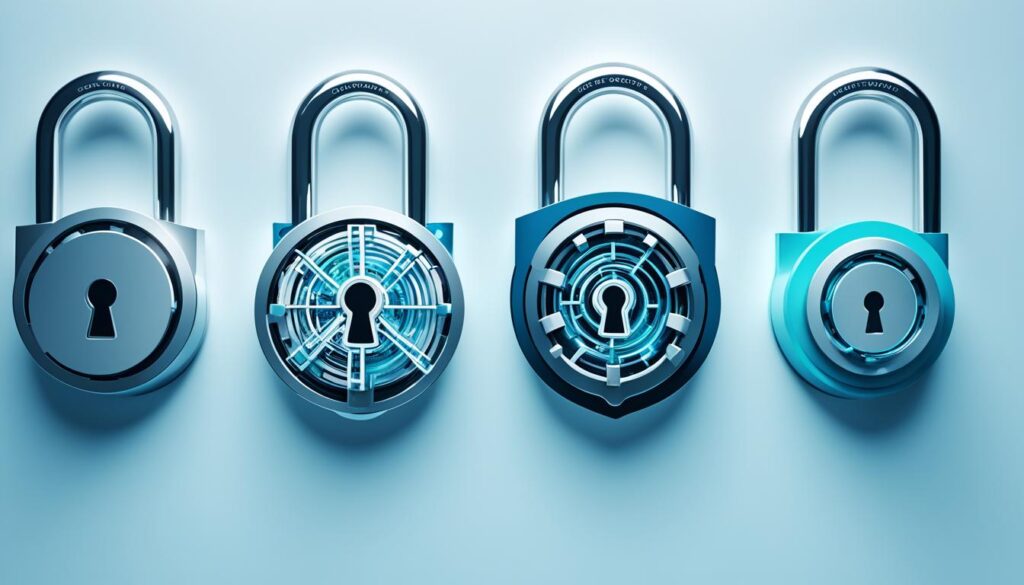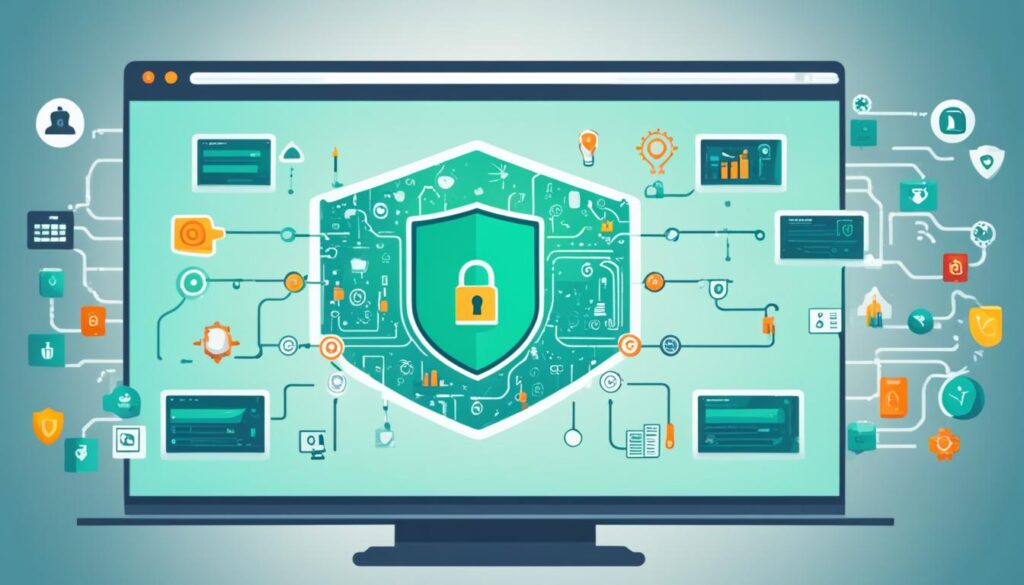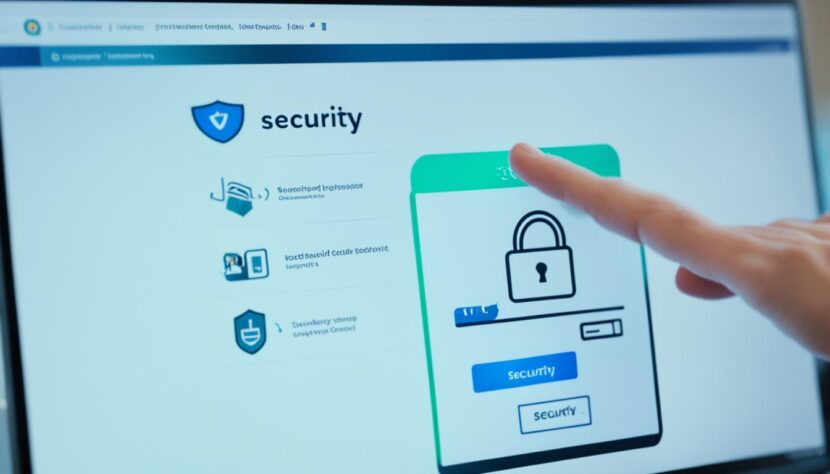Did you know a new cyberattack happens every 39 seconds worldwide? This shows how important it is to keep your computer safe.
Our cybersecurity workshop will teach you how to protect your computer. With cyber threats getting more complex, it’s key to stay ahead with the latest defenses. Join us to make your digital space safer with our computer security training and secure computing practices.
Key Takeaways
- Understanding the importance of PC security
- Recognizing and mitigating common cyber threats
- Implementing effective malware protection techniques
- Setting up and configuring firewalls
- Enhancing data privacy measures
- Continual education on cybersecurity trends
- Basics of ethical hacking and penetration testing
Introduction to PC Security
In today’s digital world, keeping our personal and work data safe is crucial. It’s key to understand the importance of PC security to protect our sensitive info from online threats.
Why PC Security is Essential
With our lives more connected to technology, PC security is vital. It’s not just about keeping our data safe. It’s also about keeping our businesses running smoothly.
Being aware of cybersecurity is crucial. This awareness lets us spot threats early and protect our digital stuff. It helps stop identity theft, financial loss, and unauthorized data use.
The Evolution of Cyber Threats
Cyber threats have changed a lot over time. What used to be simple viruses are now complex attacks aiming to break into our systems. These threats keep getting better, so we must keep up with new security steps.
Knowing about these threats is key. Old threats were mostly a bother, but now they can be very harmful, aiming for money or political goals. This shows why strong PC security is so important to stay safe.
Understanding Cybersecurity Threats
In today’s digital world, cybersecurity threats are always changing and getting more complex. They can take many forms, each one posing a big risk to people and companies. It’s crucial to know about these threats to protect against them.

Common Types of Cyber Threats
Cyber threats include many types of malware and harmful activities. Here are some of the most common ones:
- Phishing: A trick used to get sensitive info by pretending to be trustworthy.
- Ransomware: Malware that locks your data and demands payment to unlock it.
- Spyware: Secret software that gathers info on what you do.
- Viruses and Worms: Harmful programs that spread to other devices.
The Impact of Cyber Attacks on Individuals and Organizations
Cybercrime does more than just cost money. It can disrupt personal and business life. People might lose their identity or personal data. Companies could lose valuable information, get a bad reputation, and face legal issues.
| Type of Cyber Threat | Impact on Individuals | Impact on Organizations |
|---|---|---|
| Phishing | Identity Theft, Fraudulent Transactions |
Data Breaches, Financial Loss |
| Ransomware | Loss of Personal Data, Financial Extortion |
Operational Downtime, Ransom Payments |
| Spyware | Privacy Invasion, Unwarranted Data Collection |
Corporate Espionage, Sensitive Data Exposure |
| Viruses and Worms | Data Corruption, System Downtime |
Network Disruption, Costly Recovery Efforts |
The rise of cybercrime shows how vital it is to know about cybersecurity threats and malware. By understanding these risks, people and companies can protect their online assets.
Cybersecurity Training for Beginners
In today’s digital age, knowing cybersecurity basics is crucial for everyone. For those starting their cybersecurity journey, practical training can greatly improve their skills. It helps protect personal and professional data.
- Recognizing Cyber Threats: It’s vital to understand different cyber threats. Phishing, malware, and ransomware are just a few threats to watch out for.
- Implementing Security Measures: Start with simple steps like strong passwords, two-factor authentication, and keeping software updated.
- Threat Prevention Techniques: A key part of online safety for beginners is preventing threats. Learn to spot suspicious activities and avoid risky online actions.
Joining cybersecurity workshops or training is very helpful. These sessions teach about vulnerabilities, attack vectors, and defense strategies. For example, a Security Lead at Verizon gains real-world experience by leading projects and managing security.
Good cybersecurity habits are key. Avoiding public Wi-Fi for sensitive info, backing up data, and knowing how to prevent threats can boost security.
Learning and using cybersecurity basics are vital for protecting your online presence. By following this beginner’s guide to online safety, you can lower your risk of cyber attacks.
Malware Protection Techniques
In today’s digital world, keeping your PC safe from harmful software is crucial. Using reliable antivirus software and safe browsing habits are key to protecting your system.

Antivirus Software
Antivirus software is your first line of defense against malware. These antivirus solutions scan, find, and remove malware. This keeps your system safe from new threats.
- Real-Time Scanning: It always checks your system for suspicious actions.
- Automatic Updates: It keeps your antivirus current with the latest threat info.
- Comprehensive Protection: It protects against many types of malware, like Trojans, viruses, and ransomware.
Safe Browsing Practices
Safe browsing is key to avoiding malware. Being careful online can lower the chance of getting infected.
- Be Mindful of Links: Don’t click on links from unknown sources.
- Use Secure Websites: Make sure websites you visit use HTTPS for a secure connection.
- Regular Updates: Keep your browser and plugins updated to avoid exploits.
Using antivirus software and safe browsing helps protect your system. Staying updated on the latest internet security tips is also important. Researchers found a Linux malware, Sedexp, showing the need for strong defense against malware.
Firewall Configuration Best Practices
Having a strong firewall setup is key for keeping your network protection up to date. With threats always changing, it’s vital to have a secure network setup. This helps protect your data and systems.
Types of Firewalls
There are different firewalls you can use, depending on what you need:
- Packet Filtering Firewalls: These firewalls check each piece of information and decide if it can pass or not, based on set rules.
- Stateful Inspection Firewalls: These offer better security by tracking active connections and making decisions based on the traffic’s context.
- Proxy Firewalls: These work as middlemen for requests from clients to other servers, adding more protection.
- Next-Generation Firewalls (NGFW): These combine traditional firewall tech with extra features like checking encrypted traffic and stopping intrusions.
How to Set Up a Firewall
Setting up a firewall right is key for a secure network. Here’s how to do it:
- First, figure out what network resources you want to protect and map your network.
- Then, pick the right firewall setup for your network’s size and complexity.
- Make firewall rules and policies that fit your security needs, and update them as threats change.
- Keep an eye on firewall logs for any odd activity, and tweak your setup as needed.
- Test your firewall to make sure it’s working right and giving you the network protection you need against breaches.
The Port of Seattle faced a big cyber attack, showing how important it is to have strong and up-to-date firewall policies. Such events stress the need for a well-secured network to stop unauthorized access and lessen damage.
Data Privacy Measures
Data privacy is key to keeping sensitive info safe and private. By using strong data privacy tools, people and companies can guard their personal data. This builds trust. Let’s look at why data privacy matters and the tools that help keep online info safe.
Importance of Data Privacy
Keeping personal data safe is crucial to stop identity theft and protect our freedom. Having control over our info means we can keep our online lives private. This keeps us safe from unwanted access and data breaches.
In businesses, strong data privacy steps build trust with customers. They feel safe knowing their info is well-protected.
Tools to Enhance Data Privacy
Many tools help make our online security and data protection better. These include encryption software, VPNs, secure browsers, and password managers. Each tool is important for reducing risks and keeping our online privacy safe.
| Tool | Function | Benefit |
|---|---|---|
| Encryption Software | Encrypts data to prevent unauthorized access | Protects sensitive information |
| VPN | Secures internet connection and masks IP address | Maintains online privacy |
| Secure Browsers | Offers enhanced security features | Prevents tracking and data breaches |
| Password Managers | Stores and manages strong passwords | Reduces risk of password theft |
Using these tools is key to better online privacy and keeping personal data safe. By adding these steps, both people and companies can make sure their private info stays secure and private.
Network Security Fundamentals
Understanding the basics of network security strategies is key today. It’s important to know how to secure both wireless and wired networks. This knowledge helps fight off threats effectively. Knowing common network weaknesses and how to protect your setup is crucial.

- Develop Robust Policies: Create strict rules for who can access systems and how data is handled. This boosts security and keeps securing wireless networks consistent.
- Implement Advanced Encryption: Use strong encryption like WPA3 for wireless networks. This stops unauthorized access and keeps data safe.
- Regular Network Assessments: Do regular checks to find and fix network weaknesses. Scanning often can spot and fix issues before hackers can exploit them.
Good network security means using a mix of hardware and software strategies. By focusing on these basics, you can make your network strong against cyber threats.
| Security Measure | Description | Benefit |
|---|---|---|
| Firewall Implementation | Setting up firewalls to watch and control network traffic according to security rules. | Keeps out unauthorized access and stops breaches. |
| Intrusion Detection Systems | Systems that spot and alert about suspicious actions and rule breaks in real-time. | Provides quick alerts and actions against threats, boosting security. |
| Network Segmentation | Breaking a network into smaller parts to improve performance and security. | Slows down malware spread and limits access to sensitive data. |
Using these security steps lowers the chance of attacks. This makes your network safer and more dependable.
PC Security Workshop Programs
Starting a PC security workshop journey gives you deep insights into cybersecurity. You’ll learn from basic to advanced security techniques. These workshops aim to give you the skills to keep your digital world safe.
What to Expect in a PC Security Workshop
Joining a PC security workshop means getting a full course on modern PC security. The PC security workshop syllabus covers important topics like:
- Securing home networks
- Creating and managing strong passwords
- Spotting and avoiding phishing emails
- Keeping software and devices up to date
These workshops let you practice what you’ve learned in real situations. This makes your cybersecurity skill development more effective.

Key Skills Taught
Security training workshops teach vital skills for protecting against cyber threats. You’ll learn about:
- Different types of malware and how to protect against them.
- Setting up and managing firewalls for network security.
- Keeping data private with the right tools and methods.
- Staying updated on the latest security trends and threats.
By taking part in these workshops, you’ll know how to keep your personal data safe. It’s important to use strong cybersecurity practices to protect your digital info in today’s connected world.
For more tips on cybersecurity, check out the Computer Tech Squad.
Ethical Hacking and Penetration Testing
With cyber threats on the rise, learning ethical hacking basics and penetration testing is key for cybersecurity pros. These steps are vital for finding and fixing system weaknesses.
Understanding Ethical Hacking
Ethical hacking means testing systems with simulated cyber attacks to find security issues. Ethical hackers use the same methods as bad hackers but for good, aiming to protect systems.
To begin with ethical hacking basics, you need to know many techniques and methods. You must understand how hackers think and what they know about networks, operating systems, and security. This knowledge helps in simulating attacks and improving security.
Penetration Testing Techniques
Penetration testing is a key part of ethical hacking. It checks a system’s security by finding weak spots that hackers could use. Here are some common methods:
- Black Box Testing: The tester doesn’t know the system, like an outside hacker would.
- White Box Testing: The tester knows everything about the system, giving a detailed check.
- Gray Box Testing: This combines black and white box testing, giving some system info for a better test.
Using these methods, companies can deeply check their systems for weaknesses. This helps fix issues before they turn into big security problems. Regular testing keeps systems strong against new cyber threats, protecting data and integrity.
Adding these tactics to your cybersecurity plan makes your systems and networks more secure against attacks.
Risk Management Strategies
Managing risks in cybersecurity is key to keeping your digital world safe. It means spotting risks and using the right ways to fix them. This helps protect your systems from cyber threats.
Identifying Potential Risks
First, you need to find out what threats could hit your systems. This includes things like malware, phishing attacks, and ransomware. By watching your IT closely, you can find weak spots that bad guys might use.
Mitigating Security Risks
After finding threats, you need to stop them. This means keeping your security software updated, setting up firewalls, and teaching your team about online safety. Also, having a plan for when things go wrong helps you deal with problems fast and lessen the damage.
Creating an Incident Response Plan
In today’s digital world, not being ready for a cybersecurity breach can lead to big problems. Having a good incident response plan is key to quickly handle threats. A solid plan makes sure your team knows what to do in a crisis.
Key Components of an Incident Response Plan
An incident response plan is more than a simple document. It’s a flexible guide that changes with new cyber threats. Here are the main parts:
- Preparation: Set up roles, responsibilities, and how to communicate.
- Identification: Spot and report possible cybersecurity issues.
- Containment: Keep affected systems separate to stop more damage.
- Eradication: Get rid of the security breach’s root cause.
- Recovery: Bring systems back and check they’re working right.
- Lessons Learned: Look over the incident to make future incident handling procedures better.
Steps to Follow During a Cybersecurity Incident
Handling a cybersecurity breach well needs a clear plan. Here are important steps to follow:
- Detection and Alert: Watch networks for bad activities and send out alerts.
- Assessment: Figure out how serious and big the incident is.
- Communication: Tell people involved and use set communication plans.
- Containment and Mitigation: Use quick steps to stop the breach from getting worse.
- Investigation: Do a deep look into the incident to know what happened.
- Remediation: Fix problems to stop similar issues in the future.
Essential Resources and Tools
| Resource Type | Description | Examples |
|---|---|---|
| Detection Tools | Find and alert on strange activities | Snort, Splunk |
| Communication Platforms | Help with reporting incidents and sending updates | Slack, Microsoft Teams |
| Investigation Tools | Look into and understand the breach details | Wireshark, ELK stack |
| Mitigation Software | Stop more damage and secure systems | Firewall settings, Patch management systems |
By using these important parts and steps, your company can improve cybersecurity crisis management. This helps protect important assets from threats.
Technologies to Enhance PC Security
The technology world is changing fast, bringing new ways to make our PCs safer. It’s important for everyone to know about the latest security tools and innovations. This helps keep our digital lives safe.
Latest Security Tools and Software
There’s a big focus on creating PC security solutions that protect us fully. These solutions cover many areas, like making browsers safer, protecting while running apps, and how apps are shared. For example, Apple has updated their browser screens and added strong protection in macOS Sequoia. This helps fight off harmful threats.
Also, new security software is making our digital world stronger. Apple has updated their app review rules to match these new security steps. This ensures apps are safe for everyone. The Apple Entrepreneur Camp applications for underrepresented founders and developers show Apple’s dedication to a secure online space.
Here’s a table that compares some new security tools and software. It shows what they do and their main benefits:
| Security Tool | Key Features | Benefits |
|---|---|---|
| Advanced Runtime Protection | Real-time threat monitoring, Automated response mechanisms | Acts fast against threats, reduces damage, boosts PC security. |
| Browser Choice Screens | Customizable browser settings, Enhanced privacy options | Gives users control over their web use, strengthens privacy. |
| App Review Guidelines Update | Stricter security checks, Regular updates | Keeps security high, shields users from risky apps. |
In conclusion, these new cybersecurity technologies are changing how we protect our online lives. By using these innovations, we can stay ahead of cyber threats.
Staying Updated with Cybersecurity Trends
Cybersecurity changes fast, so it’s key to keep up with new info. This is true for both experts and beginners. Knowing the latest security trends helps you defend better.
Importance of Continuous Learning
Learning about cybersecurity non-stop is vital. Cyber threats get more complex daily. Keeping your skills sharp helps you fight off attacks. It also keeps you in line with the rules and standards.
Resources for Staying Informed
There are many ways to stay on top of cybersecurity news. Here are some tips:
- Webinars: Live talks from top experts.
- Online Courses: Sites like Coursera and Udemy have special courses.
- Industry Blogs: Check out blogs from well-known cybersecurity companies.
- Newsletters: Sign up for newsletters with the latest cybersecurity news.
- Community Forums: Join forums like Reddit and Stack Exchange to share and learn.
Keeping up with cybersecurity trends makes you proactive, not just reactive. Always be learning to protect your online world well.
Conclusion
As we finish this PC Security Workshop, it’s clear that keeping your digital world safe is key. We’ve covered how important PC security is and how to handle cyber threats. You now have the knowledge to protect yourself and your groups from cyber attacks.
It’s important to take steps like setting up firewalls and keeping your data private. Learning about ethical hacking and risk management helps too. The skills and tips shared here are ready for you to use right away.
Learning never stops in keeping your digital world safe. By always learning new things and keeping up with cybersecurity news, you help protect your own stuff and make the internet safer for everyone. The fight against cyber threats is ongoing, and every step you take to use these strategies is important.
FAQ
What can I expect from a PC Security Workshop?
Why is PC security essential?
What are some common types of cyber threats?
Are there training programs suitable for beginners?
How can antivirus software help with malware protection?
What are the best practices for configuring a firewall?
Why is data privacy important?
What strategies can enhance network security?
What key skills are taught in a PC Security Workshop?
What is the role of ethical hacking and penetration testing in cybersecurity?
How can I identify potential cybersecurity risks?
What steps should I include in an incident response plan?
What are some of the latest technologies to enhance PC security?
How can I stay updated with the latest trends in cybersecurity?
Source Links
- Can your monitors keep pace with advances in telehealth? – Samsung Business Insights
- If Your Security System and Communications Aren’t Shareable, How Can They Help You?
- What is WRAP and how can it help train AI more efficiently?
Created by Www.TheComputerTechSquad.comIn today’s digital world, cybersecurity training and staying up to date with the latest security measures is of utmost importance. One key aspect of ensuring a secure environment is proper firewall configuration. But how can businesses and individuals benefit from this knowledge if they are unable to share their security system and communication protocols? The answer lies in source links.
Source links, also known as open-source solutions, allow users to access and contribute to a shared pool of information. This not only promotes collaboration within the cybersecurity community but also enables individuals and organizations to have a deeper understanding of various security practices and solutions.
By utilizing source links, cybersecurity professionals can enhance their knowledge, learn more about effective firewall configuration, and stay up to date with the latest trends and threats. These links provide a centralized platform where experts can share their expertise, tools, and methodologies with others, fostering a culture of continuous learning and improvement.
Moreover, source links facilitate the development of innovative solutions. By providing access to a wide range of resources, including code snippets, documentation, and case studies, they empower security enthusiasts and developers to build upon existing practices and develop new technologies that address emerging threats and challenges.
In conclusion, source links play a crucial role in cybersecurity training and maintaining a robust security infrastructure. By embracing open-source solutions, individuals and organizations can stay ahead of the curve, continuously improve their security practices, and contribute to the collective knowledge in the cybersecurity community. So, let’s leverage the power of source links and work together to fortify our digital defenses.


